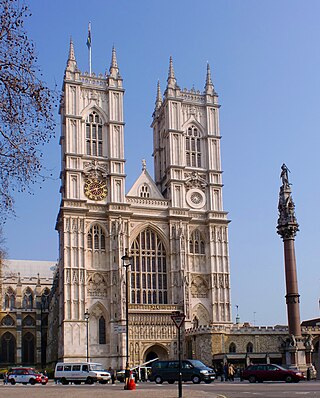
Westminster Abbey, formally titled the Collegiate Church of Saint Peter at Westminster, is an Anglican church in the City of Westminster, London, England. Since 1066, it has been the location of the coronations of 40 English and British monarchs, and a burial site for 18 English, Scottish, and British monarchs. At least 16 royal weddings have occurred at the abbey since 1100.

George VI was King of the United Kingdom and the Dominions of the British Commonwealth from 11 December 1936 until his death on 6 February 1952. He was also the last Emperor of India from 1936 until the British Raj was dissolved in August 1947, and the first Head of the Commonwealth following the London Declaration of 1949.
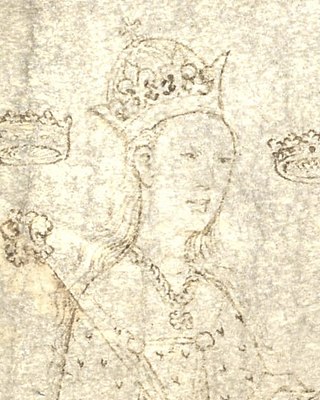
Anne Neville was Queen of England as the wife of King Richard III. She was the younger of the two daughters and co-heiresses of Richard Neville, 16th Earl of Warwick. Before her marriage to Richard, she had been Princess of Wales as the wife of Edward of Westminster, Prince of Wales, the only son and heir apparent of King Henry VI.

The House of Windsor is a British royal house, and currently the reigning house of the United Kingdom and the other Commonwealth realms. Since it was founded in 1917, there have been five British monarchs of the House of Windsor: George V, Edward VIII, George VI, Elizabeth II, and Charles III. The children and male-line descendants of Queen Elizabeth II and Prince Philip also genealogically belong to the House of Oldenburg since Philip was by birth a member of the Glücksburg branch of that house.
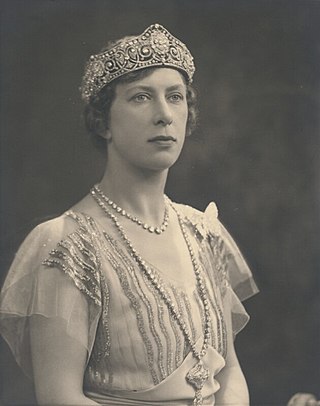
Mary, Princess Royal and Countess of Harewood, was a member of the British royal family. She was the only daughter of King George V and Queen Mary, the sister of kings Edward VIII and George VI, and aunt of Elizabeth II. In the First World War, she performed charity work in support of servicemen and their families. She married Henry Lascelles, Viscount Lascelles, in 1922. Mary was given the title of Princess Royal in 1932. During the Second World War, she was Controller Commandant of the Auxiliary Territorial Service. The Princess Royal and the Earl of Harewood had two sons, George Lascelles, 7th Earl of Harewood, and The Honourable Gerald Lascelles.
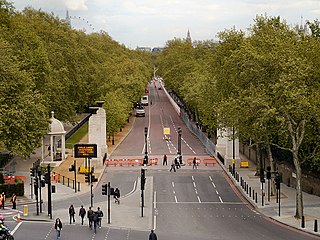
Constitution Hill is a road in the City of Westminster in London. It connects the western end of The Mall with Hyde Park Corner, and is bordered by Buckingham Palace Gardens to the south, and Green Park to the north.

Pall Mall is a street in the St James's area of the City of Westminster, Central London. It connects St James's Street to Trafalgar Square and is a section of the regional A4 road. The street's name is derived from pall-mall, a ball game played there during the 17th century, which in turn is derived from the Italian pallamaglio, literally "ball-mallet".

Baynard's Castle refers to buildings on two neighbouring sites in the City of London, between where Blackfriars station and St Paul's Cathedral now stand. The first was a Norman fortification constructed by Ralph Baynard, 1st feudal baron of Little Dunmow in Essex, and was demolished by King John in 1213. The second was a medieval palace built a short distance to the south-east and later extended, but mostly destroyed in the Great Fire of London in 1666. According to Sir Walter Besant, "There was no house in [London] more interesting than this".

Broadway is a street in the City of Westminster in London that runs between Petty France, Queen Anne's Gate, Carteret Street and Tothill Street in the north and Victoria Street in the south. It is joined on the west side by St Ermin's Hill and Caxton Street, and on the east side by Dacre Street.
Daniel Maskell was an English tennis professional who later became a radio and television commentator on the game. He was described as the BBC's "voice of tennis", and the "voice of Wimbledon".

Tothill Fields Bridewell was a prison located in the Westminster area of central London between 1618 and 1884. It was named "Bridewell" after the Bridewell Palace, which during the 16th century had become one of the City of London's most important prisons. Tothill Fields later became the Westminster House of Correction.

The Railway Clearing House (RCH) was an organisation set up to manage the allocation of revenue collected by pre-grouping railway companies for the conveyance of passengers and goods over the lines of other companies. It went on to become the major regulatory body overseeing the day-to-day running of railways in Great Britain and setting common standards for railway companies, which ensured their safety and interoperability. The RCH also produced fare structures governing many aspects of rail transport at a national level and set limits on price increases for passenger travel.
The Niagara Ice Hockey Club were an early ice hockey team in the United Kingdom. They played at the Niagara Ice Rink, York Street, close to St James's Park tube station in London. Contemporary accounts of the early history of British ice hockey refer to Niagara being the first English club champions in 1898.

Marylebone is a district in the West End of London, in the City of Westminster. Oxford Street, Europe's busiest shopping street, forms its southern boundary.
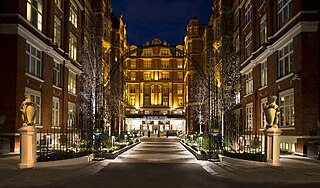
St. Ermin's Hotel is a four-star central London hotel adjacent to St James's Park Underground station, close to Westminster Abbey, Buckingham Palace, and the Houses of Parliament. The Grade II-listed late Victorian building, built as one of the early mansion blocks in the English capital, is thought to be named after an ancient monastery reputed to have occupied the site pre-10th century. Converted to a hotel in 1896–99, it became during the 1930s, through the Second World War and beyond, a meeting place of the British intelligence services, notably the birthplace of the Special Operations Executive (SOE), and where notorious Cambridge Five double agents Philby and MacLean met their Russian handlers. St Ermin's is now part of Marriott Hotels' Autograph Collection. The hotel is owned by the family of Tei-Fu Chen, founder of Sunrider International.
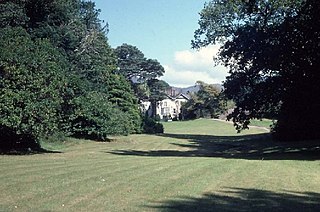
Derreen Garden lies on a promontory in Kilmakilloge Harbour on the Beara Peninsula, in Tuosist parish, near Kenmare in County Kerry. The 4th Marquess of Lansdowne (1816–

Endell Street, originally known as Belton Street, is a street in London's West End that runs from High Holborn in the north to Long Acre and Bow Street, Covent Garden, in the south. A long tall narrow building on the west side is an 1840s-built public house, the Cross Keys, Covent Garden.

Queen Anne’s Gate is a street in Westminster, London. Many of the buildings are Grade I listed, known for their Queen Anne architecture. Simon Bradley and Nikolaus Pevsner described the Gate’s early 18th century houses as “the best of their kind in London.” The street’s proximity to the Palace of Westminster made it a popular residential area for politicians; Lord Palmerston was born at No. 20 while Sir Edward Grey and Lord Haldane, prominent members of H. H. Asquith’s Cabinet, were near neighbours at Nos. 3 and 28 respectively. Other prominent residents included the philosopher John Stuart Mill at No. 40, Mansfield Smith-Cumming, the founder of MI6 at No. 21, and Admiral “Jacky” Fisher at No. 16.

Craven Street is a street in the City of Westminster, London, near Strand. A number of notable historical figures have lived in the street which was the home of Benjamin Franklin when he lived in London before the American Revolution.
This is a list of the etymology of street names in the London district of Westminster. The Westminster area has no formally defined boundaries - those utilised here are the generally accepted boundaries of: The Mall and Northumberland Avenue to the north, the river Thames and Victoria Embankment/Millbank to the east, Vauxhall Bridge Road to the south and Buckingham Gate, Buckingham Palace Road and Bressenden Place to the west. For convenience Constitution Hill and Spur Road in the Royal Parks, and the area around the Wellington Arch, are included here, as are the streets in the Leicester Square area.



















